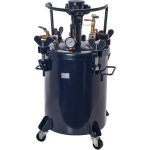- Joined
- Mar 30, 2022
- Messages
- 85
- Reaction score
- 50
- Points
- 18
Is the all/hg suitable/preferred for large scale production? The more I learn the more I start considering exploring other routes such as the boro reduction is there any advantages for large scale? I've seen many labs using all/hg method have many small reactors instead of one large one. Is this because to reaction is more efficient at small scale?
I'm interested in researching large scale routes for something like 5-25kg, I assume the all/hg will work ok but is anything else more preferee and worth switching to?
Stirring is the main issue my stirrers couldn't handle 1kg al/hg reduction so o had to monitor it constantly.
As long as I have sufficient stirring and proper amalgamation then switching to 55gal drum with stirrer powered by compressor. If this will work ok and the drum gets up to temp that would be pretty nice but wouldn't be good to have it not fully react. Ever experience a stall? Sad stuff.
I'm interested in researching large scale routes for something like 5-25kg, I assume the all/hg will work ok but is anything else more preferee and worth switching to?
Stirring is the main issue my stirrers couldn't handle 1kg al/hg reduction so o had to monitor it constantly.
As long as I have sufficient stirring and proper amalgamation then switching to 55gal drum with stirrer powered by compressor. If this will work ok and the drum gets up to temp that would be pretty nice but wouldn't be good to have it not fully react. Ever experience a stall? Sad stuff.
Last edited:

